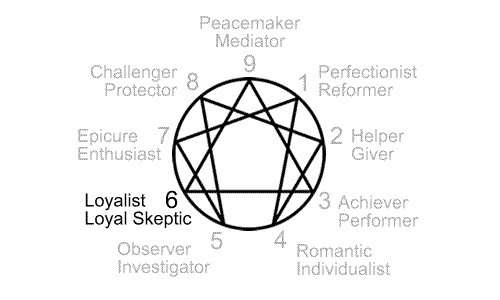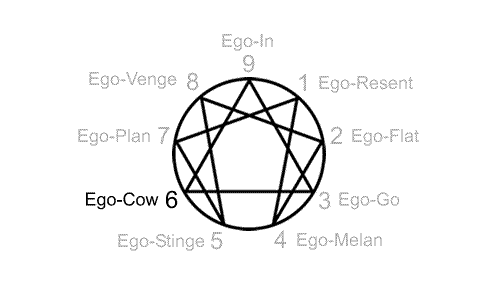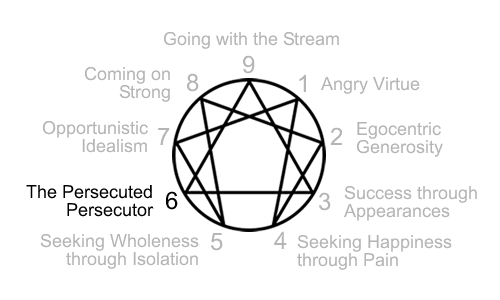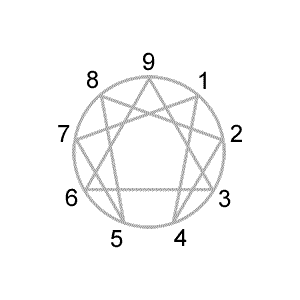Enneagram Type 6: Assurance through Mental Questioning
The core focus of Enneagram type 6

Freedom from the desire for an answer is essential to the understanding of a problem.
- Jiddu Krishnamurti
Early in life we develop an initial belief about ourselves and a compensation for that self-belief.
-
Type 6 Initial Self-Belief: “I am uncertain as I am.”
Type 6 Compensation: "I must search for someone or something that I can depend on that provides the assurance to move forward."
Over time this gets generalized beyond the self into a core focus that also shapes how we perceive and interact with the world at large.
-
Type 6 Core Focus: Assurance comes from determining what can be trusted so that internal doubts can be resolved. This requires that I find something outside myself that provides support and can be relied upon by questioning the intentions and thoughts of authorities, systems, other people, and even myself.
Personality characteristics that might arise from the type 6 core focus include:
- Plays the devil's advocate through contrarian thinking
- Tends to notice what could go wrong in situations
- Mentally prepares for worst-case scenarios
- Becomes suspicious when people behave inconsistently
- Projects imagined thoughts and feelings onto others
- Can be very loyal once someone has earned their trust
- Scans the environment and people for possible threats and danger
- Disarms others through warmth and self-deprecation
- Seeks advice and reassurance when making decisions
Enneagram author descriptions of type 6

Below are Enneagram type 6 description samplings from some popular or well-known Enneagram authors. Click on the sources after the descriptions to further explore these interpretations.
-
The Loyalist, The Committed, Security-Oriented Type: Engaging, Responsible, Anxious, and Suspicious
Basic Fear: Of having no support and guidance, of being unable to survive on their own1
Basic Desire: To find security and support1
-
How Sixes Pay Attention: (Projection) The blind spot in the way a Six pays attention is that a point of view must have first appeared in the Six’s mind in order to warrant him or her looking for supportive evidence and clues.2
Basic Proposition: You can assure life and certainty by avoiding harm (the phobic stance) or facing it (the counter-phobic stance) through vigilance, questioning, and either battling or escaping perceived hazards.2
Strengths: Perceptive, sensitive, loyal, warm, witty, courageous and strategic thinking2
Challenges: Anxious, hyper-vigilant, pessimistic, contrary, over-active imagination2
-
Energy goes into: Doubting, testing, and looking for double messages. Figuring things out through logical analysis. Playing the devil’s advocate. Showing strength. Gaining security by obtaining the goodwill of others, being loyal to others, and dedicating myself to worthy and often underdog causes.3
-
The Loyalist: Committed, practical and witty, they are worst-case-scenario thinkers who are motivated by fear and the need for security.4
-
Questioners are responsible, trustworthy, and vaue loyalty to family, friends, groups, and causes. Their personalities range broadly from reserved and timid to outspoken and confrontative.5
Focus of Attention: Sixes focus on thinking about what might go wrong and strategizing and preparing for it. A response to an early experience of danger, Sixes have an adaptive strategy that centers on detecting threats and coping with fear.6
Sources
1Book: The Wisdom of the Enneagram; Website: The Enneagram Institute
2Book: The Enneagram; Website: The Narrative Enneagram
3Book: The Essential Enneagram; Website: Dr. David Daniels
4Book: The Road Back to You
5Book: The Enneagram Made Easy
6Book: The Complete Enneagram; Website: Chestnut Paes Enneagram Academy
Type 6 Ego: Ego-Cow

The roots of the Enneagram types come from Oscar Ichazo's ego types. The ego types identified how a person was fixated in ego and the remedy for finding freedom from that.
Below are descriptions of Oscar Ichazo's ego type 6 fixation, trap, holy idea, passion, and virtue reinterpreted for today's Enneagram personality types.
Type 6 Fixation and Trap
Fixation: Cowardice comes from waiting for something or someone to alleviate doubt before taking action.
Trap: Security requires constant scanning for potential dangers and problems in order to be prepared.
The fixation of cowardice points to the mental preoccupation of the type 6 ego. The trap of security keeps an individual stuck in the fixation.
Type 6 Holy Idea
Holy Idea: Holy Faith is trusting in yourself and others that you can navigate life in spite of the doubts and questions you may have.
The fixation of cowardice and trap of security keep an individual stuck in the type 6 fixation. The way out of that fixation is through holy faith.
Type 6 Passion
Passion: Fear arises from a sense of uncertainty and doubt within. "I scan others and the world around me to locate dangers and find something to reassure me."
The passion of fear is the emotional energy that serves the fixation of cowardice and trap of security.
Type 6 Virtue
Virtue: Courage appears when you step into action as circumstances dictate in spite of any lingering doubts or fears that you may have about doing so.
The virtue of courage is what appears when the passion of fear subsides.
Personality traits of Enneagram type 6

A psychiatrist named Claudio Naranjo evolved Oscar Ichazo's ego-types into the Enneagram personality types as we use them today. Naranjo largely based the types on Ichazo's passions.
Naranjo outlined the following trait structure for type 6 (Ennea-type VI) in his books Ennea-type Structures and Character and Neurosis.
- The Persecuted Persecutor - Fear and Suspiciousness
- Fear, Cowardice and Anxiety
- Over-Alert Hyperintentionality
- Theoretical Orientation
- Ingratiating Friendliness
- Rigidity
- Pugnacity
- Orientation to Authority and Ideals
- Accusation of Self and Others
- Doubt and Ambivalence
Enneagram type 6 examples
While reading about the Enneagram types can be useful in understanding them, you eventually have to bring the types to life by seeing the many different ways they get expressed in life.
While the ideal is to be able to interact directly with people of each type, an alternative is to observe them from a distance. There are a number of ways to do this using videos. Many of these videos can be found on the Internet if you know what to look for (YouTube in particular).
- Type 6 Interviews and Self-Revelations
One method used to bring the types to life when teaching the Enneagram types involves interviewing people of a given type about how that type plays out in their life. This may be done through panels and one-on-one interviews.
Self-revelatory videos can also be useful where a person simply describes their type to a camera without the prompting of an interviewer.
Note that sometimes a person in a video may have been mistyped and may not offer an accurate representation of type when that happens.
- Type 6 Celebrities or Famous People
Once their Enneagram type is known, celebrities or famous people can also offer interesting examples of and insights into Enneagram type as revealed through interviews, lectures, writings, and the person's work.
However, it's not like the Enneagram panels, interviews, and self-revelations where people are specifically describing how they experience Enneagram type in their lives. It's more a matter of looking for glimpses into how Enneagram type is operating in the person.
It can be difficult to type someone at a distance. Look for a consensus of opinion on a person's type from multiple sources and hold it loosely. Celebrities and famous people are often typed differently by different Enneagram authors, teachers, and enthusiasts.
- Type 6 Fictional Characters
It needs to be made clear that fictional characters are not real people, even when they are based on real people. There can be a temptation to assign Enneagram type to every character in a story, but many characters don't have that kind of consistency or depth.
Not only might there be a number of different people, usually of different types, influencing the creation or portrayal of a character but often the character is nothing more than a vehicle for telling the story and moving it along.
While once in a while a character appears that you can attribute an Enneagram type to, generally it's more accurate to look at specific scenes as examples of a type rather than the character as a whole.
Tom Condon wrote a book called The Enneagram Movie & Video Guide that you may find useful for seeing type in fictional characters.
- Type 6 Songs and Lyrics
Although they do exist, there are few song lyrics that can be attributed to one particular Enneagram type. Most songs have both lyrical and musical elements that can be attributed to a number of different Enneagram types.
Songs are extremely subjective. There are many songs that listeners, and even performers, interpret in a very different way than the song writer intended. A number of songs also emphasize the sounds of words rather than their meaning.
As such, different people hearing the same song often will experience it as representing different Enneagram types.
Enneagram type 6 variations
There are a number of variations or flavors of type 6 that help explain why two people of the same type seem different. Click below for more info about variations of type 6.
Type 6 mistypes
Some people correctly identify their Enneagram type on their first try. For most other people determining type can take some time.
If you feel that you may have wrongly typed yourself as type 6 and have one or more alternative candidate types in mind then click on a link below to take a quick Enneagram test comparing type 6 to another type that may instead be your type.
Enneagram Tests to Help Determine Type

The Enneagram personality types consist of nine basic types. One of the types will be more dominant than the others. This dominant type is said to be "your Enneagram type".
Although there are nine basic Enneagram types, there are also many variations within each type as defined by such concepts as wings, centers, and instincts.
You can explore these variations using the type preference test below or one of the many other tests available on this website.
-
Enneagram Type Preference Test
This test produces a scored list of all nine types.
Questions are forced-choice, similar to the method used by the Riso-Hudson Enneagram Type Indictor (RHETI).
Use to determine type, wings, gut/heart/head types, and tri-center. -
Enneagram Type Comparison Test
This test compares any two types. The preferred type will have the higher score.
Use when you've narrowed your type down to two or three possibilities you'd like to compare.
Click here for the Complete Guide to the Enneagram.
This free guide explains- the nine Enneagram personality types
- the many type variations within type
- where the types came from (origins and history)
- how the types use the Enneagram symbol
Click here for Enneagram tests.
These free tests help you find your- primary type
- candidate types
- preferred wing
- intinctual subtype
- instinctual variant stacking
- center types (gut, heart, and head)
- tri-center with wings